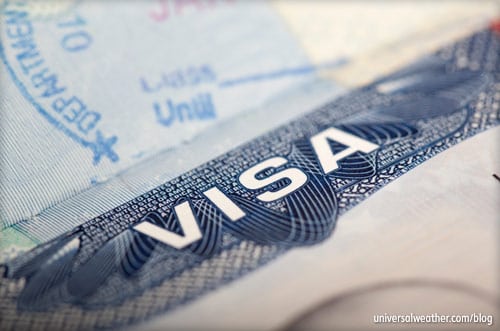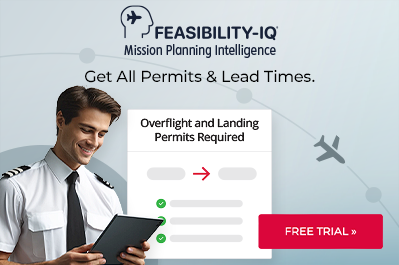Operating under the Visa Waiver Program: Top FAQs from Business Aviation Operators

This aviation blog post is part of a series on the visa waiver program and continues from our last post: “Visa Waiver Program and Business Aviation: Answers to Common Questions.“
Operating as a signatory carrier into the U.S. under the Visa Waiver Program (VWP) is a straightforward and usually trouble-free process. As VWP authorization goes with the operator, and not the aircraft, there’s a great deal of freedom to lease or charter aircraft while still maintaining VWP benefits, as long as the operator maintains operational control. However, there are crew and operator responsibilities to consider when operating under this program. Best practice is to clearly understand VWP rules and responsibilities and confirm passenger documentation prior to each international flight.
1. Are there negative aspects to registering under the VWP?
When bringing passengers into the U.S. under the VWP, a signatory carrier is technically responsible to ensure passengers depart the U.S. Some operators are concerned with liability and take this as a reason not to join the program. In practice, we’ve never heard of a case where an operator ran into problems regarding passenger departure from the U.S. On arrival, the U.S. Customs officer may request evidence of a return flight. We usually use a trip sheet (data for a trip that includes information like the full schedule and crew and passengers details for each leg) as evidence, but there may be cases when evidence of onward travel could be required. One example is when a passenger arrives in the U.S. on a one-way corporate flight. Non-U.S.-based operators should be aware that, when processing a U.S. Customs bond, they’ll be making financial disclosures to the U.S. government.
2. If an operator leases their aircraft to another operator, or brings in a replacement aircraft, will VWP status be maintained?
VWP authorization goes with the operator and not the aircraft. So long as the flight is operated under the approved VWP company name and their operational control, you’re free to lease or charter aircraft and still enjoy VWP benefits. Likewise, if your aircraft is under management – and the management company has operational control and is a VWP participant – you can take advantage of VWP benefits. Subsequently, if an operator with an approved VWP leases their aircraft to another operator who will have operational control of that aircraft for the period of the lease, the lessee is not able to utilize the lessor’s VWP.
3. What are crew responsibilities when operating under a VWP?
We find it best practice to always carry a copy of your VWP authorization onboard the aircraft in case you have to show it to U.S. Customs. Confirm that all non-U.S. national passengers either have a U.S. visa or have obtained an Electronic System for Travel Authorization (ESTA). An ESTA approval number is a 15-20 digit sequence, and it’s possible to check validity online for verification purposes. Notify U.S. Customs early if you’ll be transporting anyone under a VWP, as this will prevent clearance delays on arrival. VWP does not change any U.S. Customs prior-notification requirements. Check with your 3rd-party provider on which airports you may land at and confirm that the airport can process non-U.S. nationals.
4. What can go wrong if you’re not VWP-approved and passengers do not have visas?
Private non-revenue and charter (non-scheduled commercial) aircraft arriving into the U.S. with non-U.S. nationals without visas – if the operator is not a VWP signatory carrier – will be subject to duty-officer determination as to what to do. Passengers may be deported at the operator’s expense, and multi-hour delays can occur.
Aircraft arriving into the U.S. who are not Signatory Carriers and have non-U.S. nationals without visas are subject to a variety of consequences. Customs and Border Protection may have the passengers who arrive
without a visa be deported at the operator’s expense, you may face multi-hour delays, and there may be fines levied on the PIC and Operator.
If a mistake has been made, the officer may decide to make a one-time visa exception with a possible fine and administrative cost. Don’t count on this and avoid non-compliance as passengers may be held for hours, you may face heavy penalties, and your operations may be delayed. Keep in mind that fines do not happen on the ramp. If an officer makes a ‘recommendation for a fine,’ this will be forwarded to Washington D.C. for consideration. Operators do have the right to appeal.
Conclusion
Becoming a VWP-signatory carrier is not a difficult procedure, and the benefits can be invaluable in maximizing operational flexibility of private non-revenue or charter (non-scheduled commercial) aircraft. Obtaining a U.S. visa can be a lengthy process for passengers and can often rule out a passenger traveling on a short-notice private non-revenue or charter (non-scheduled commercial) flight. Even if you don’t use it on a day-to-day basis, having VWP-signatory carrier authorization represents a valuable asset and a huge operational advantage when you need to use it.
Questions?
If you have any questions about this article, contact me at saadfarid@univ-wea.com.




